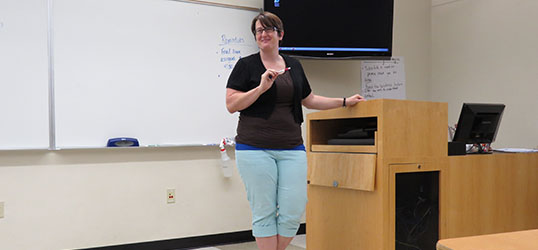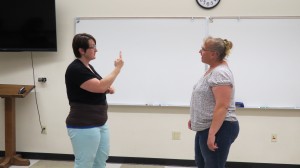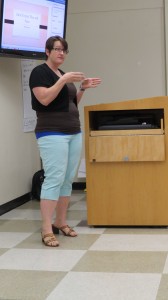
Cari Carter is an American Sign Language professor here at Yuba College. She has been teaching both ASL 1 and ASL 2 since 2009. Her life with American Sign Language did not start here, though.
Carter did not initially take ASL when she began attending American River College. She instead took Spanish for her foreign language requirement, like many do. Unlike those many people, though, she was not successful in her attempts at Spanish. Carter then decided to take ASL instead and she fell in love with the language.
When asked about what stuck out to her about ASL, Carter replied, “I never thought of myself as a visual learner but when I started learning ASL, for some reason I would see a sign and be able to recall it very easily. For me, I like to be able to connect a concept to a sign… It made sense to me in ways English never did and certainly in ways Spanish never did.” During her time at American River College, Carter met her husband Devon, who just happens to be deaf. Carter, who at the time was in ASL 3, was required to go to deaf events. As she met more deaf people, she was eventually introduced to her husband. They have been together for about 15 years.

After her husband her began dating, they moved to Rochester, New York, where Carter began to attend the University of Rochester. This is where she received her Bachelor’s in American Sign Language. She then went to Western Oregon University, which is where she received her Master’s Degree in Interpreting Studies.
Carter also teaches at interpreting workshops but she does not and will not teach ASL 3, 4, and 5. “I don’t have the level of fluency needed for levels 3, 4, and 5. They really require a deaf person to teach it because there’s such a nuance of things, such little things that I know and I could teach you but you wouldn’t be able to understand them like you would seeing them from a person who is native.”
“I encourage people to have different experiences with teachers,” Carter said when asked about deaf teachers teaching ASL. She understands the intimidation of having a deaf professor, especially in ASL 1, but she believes it is a good experience. It opens students to a different ways of signing and with a better understanding of ASL and deaf culture.
Carter, like many, was ignorant of deaf culture when she began to take ASL. She explained how taking and teaching these classes has opened up many doors for her and changed her beliefs about those who are deaf or hard of hearing. “I often identify more with the deaf community than I would with the hearing mainstream community… I like those cultural values
which are similar to Hispanic cultures and other cultures. I like that they are very cooperative with one another and how they are supportive of one another. I like that idea instead of being individual like we are in American culture.”
She believes that teaching ASL has also helped her look at the language differently. Sometimes she gets questions from students asking why things are a certain way. These questions take her back to the basics of the language and she, too, begins to wonder why. She likes to be able think about and look back at the roots of the language from a different perspective than before.

Carter also spoke about some of the challenges between her and her husband since he is deaf. She explained how most of the problems between her and her husband were cultural. One issue that arose between them was time. Carter spoke about how she was raised to be punctual and how in deaf culture being punctual is not a big deal. There are also other complications such as signaling to one another. “For me, it was about living in a world where I can’t just be like ‘Hey!’… How do I signal to someone who cannot hear me? It’s like learning how to navigate that world and figure out how to get his attention,” Carter said.
Another part that is different about their relationship is parenting their children. Because her husband cannot hear their baby cry, he always has to carry a baby monitor that flashes a light indicating there is a sound on the other end. Carter stated, “It’s just different. It’s not bad. It’s not challenging, I would say, it’s just kind of thinking outside the box.”
While there are some parts that are in deaf culture that catch her off guard, there is not much that she doesn’t like about it. Overall, she loves the culture and the language and recommends for others to give it a shot. “It’s not for everyone, though… You do have to be spatially minded and a visual learner. It doesn’t mean you can’t, but it just means some people find it easier than others. But, yes, I highly recommend it… and I love the deaf culture because you get to meet even more people and start to realize how many deaf people are in your world.”
Comment Policy: Comments are welcomed and encouraged. However, the editorial board reserves the right to edit or delete, without notice, any comments submitted to the blog. For more details, see our full Comment Policy.